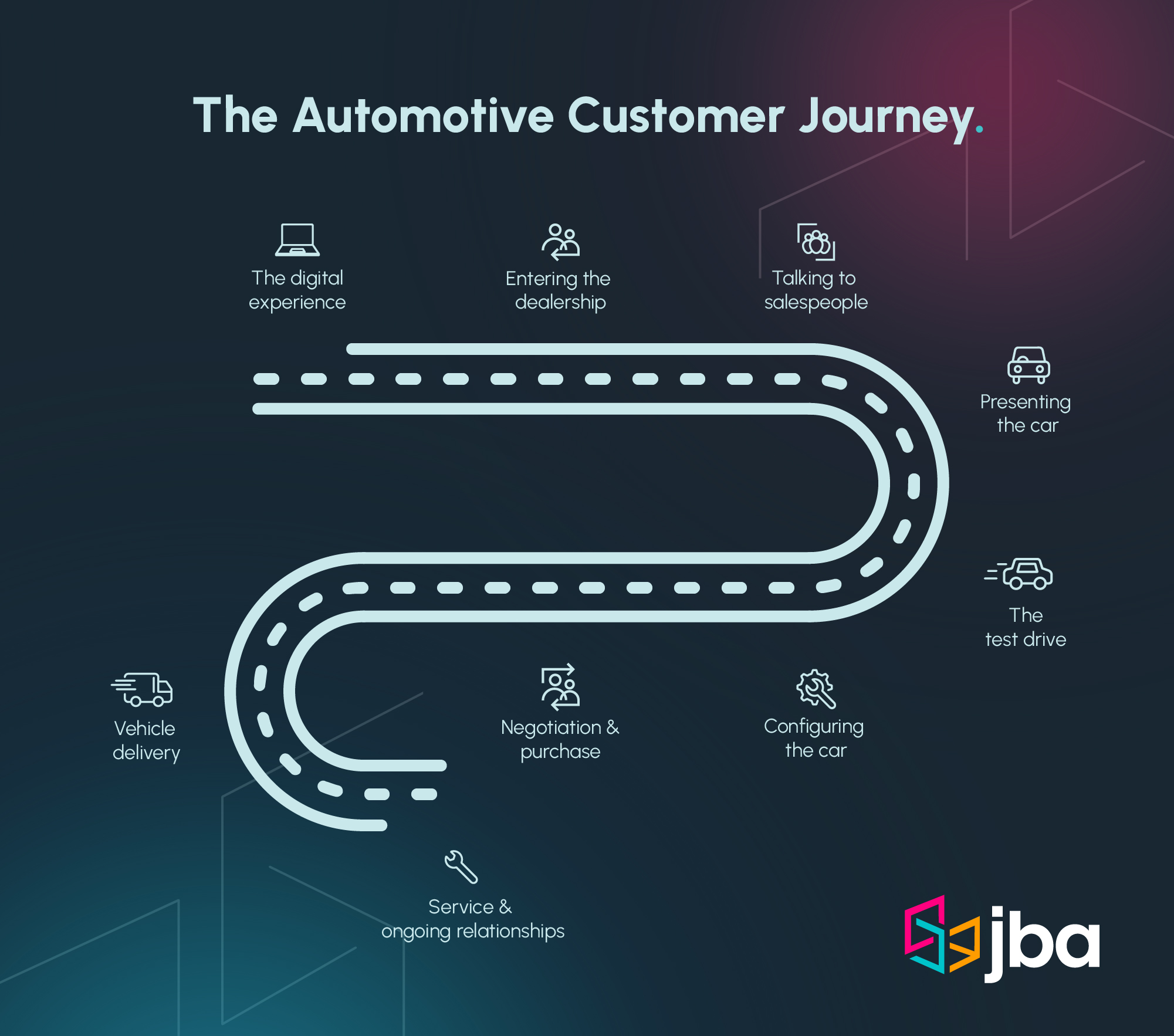Understanding and enhancing the automotive customer experience is essential to the success of your business.
As the American memoirist and poet, Maya Angelou once said, “I’ve learned that people will forget what you said, people will forget what you did, but people will never forget how you made them feel.”
This applies to the automotive customer experience as how you treat customers and engage with them, is what leaves a lasting impression.
The way customers make their purchase decisions is changing, and this has an impact on the way they buy a car. Gone are the days when customers would turn up to a dealership, spend hours looking at different makes and models, then they would make their decision.
Now, they’ve carried out most of their research and have a pretty solid understanding of what they want before they’ve entered the showroom. Thanks to technology, customers have access to more information than ever before, and to remain competitive, car brands and dealerships must embrace these digital channels.
In this blog post, we’re going to walk you through the different strategies when it comes to improving automotive customer experience and we’ll also be analysing the changing customer journey so that you can improve each touchpoint.
Why the Automotive Customer Experience is Key
First things first; what exactly do we mean by ‘customer experience’? In the automotive industry, this goes beyond just delivering great service as you and your team need to create emotional connections and long lasting memories to build customer loyalty.
It’s not enough for your sales team to ‘sell cars’ without understanding the wants and needs of the customer. I think we can all agree that at one time we’ve been in a car showroom and encountered an unpleasant experience. It’s off-putting when all the sales team is interested in is hitting sales targets as customers want to feel valued.
By providing exceptional automotive customer experiences, you have the potential to create a domino effect, where satisfied customers drive new business through referrals.
Today’s consumers expect more than just a transaction; they want personalised interactions, convenience, and transparent communication throughout their automotive journey (something we’re covering in more detail below).
Whether it’s the excitement of purchasing a new car, the reassurance of a hassle-free service experience, or the prompt resolution of any issues, every touchpoint with your customers plays a pivotal role in shaping their perception of your dealership.
By focusing on enhancing the automotive customer experience, you can build a loyal customer base that not only returns for future purchases and services but also becomes your advocate in the competitive market.

Empowering Your Team for Exceptional Customer Service
The most important part of improving automotive customer experience is empowering your sales team.
This approach extends beyond their sales capabilities as they need to understand the importance of engaging the customer, which starts with effective training.
Automotive Sales Training
Effective Automotive sales training equips your team with the knowledge, skills, and tools necessary to understand customer needs, build rapport, and deliver personalised experiences.
First and foremost, automotive sales training ensures that your team stays up-to-date with the latest product knowledge and industry trends. Having a deep understanding of the vehicles and the thought that has gone into their design empowers your salespeople to answer customer questions accurately, make relevant recommendations, and showcase the unique selling points of each vehicle personalised to them.
Additionally, by truly understanding customer preferences and pain points, your team can tailor their approach and product offerings, leading to a more satisfactory customer experience.
Sales training can also help with customer relationship management, teaching your team how to nurture long-term relationships with customers, emphasising the value of post-sale service.
All of these go well beyond what even the best online experiences can offer them.
At JBA, we go beyond the usual product-led automotive sales training, focussing heavily on the customer experience. Whilst sales are important (and we understand you need to make a profit) the customer experience and how they engage with your team is paramount. When we partner with a new client, we take the time to understand their unique challenges, developing bespoke training solutions to suit. To find out more about how we can help you, get in touch.
Encouraging empathy and active listening
In the automotive industry, where purchases often involve significant investments and emotions, empathetic interactions can make a real impact on customers.
Active listening is a fundamental skill that enables sales representatives to fully understand what customers want and need. When team members actively listen, they show genuine interest in the customers’ concerns, creating a supportive and understanding environment.
Furthermore by taking the time to listen attentively, they can gather crucial insights that help tailor recommendations and solutions, leading to higher customer satisfaction and trust.
Empathy and active listening go hand-in-hand to create a positive and memorable experience that keeps customers coming back.
By encouraging these skills, you empower your team to build meaningful relationships with customers, not just for one-time transactions but for repeat business. Sales representatives who show empathy and actively listen are more likely to anticipate customer needs, exceed expectations, and set your dealership apart from competitors.
Handling customer complaints and resolving issues
Complaints are inevitable in any business, but how they are handled can make a huge difference.
When your team is trained to handle customer complaints effectively, it demonstrates a commitment to putting the customer first and addressing their concerns promptly. By actively listening to the customer and showing empathy, your team can diffuse tense situations and create a sense of understanding and respect.
Furthermore, when customers see that their complaints are taken seriously, it instills confidence in the dealership’s ability to stand behind its products and services.
This professional way of handling complaints can help turn dissatisfied customers into loyal advocates. When customers experience effective resolutions to their issues, they are more likely to feel valued and appreciated, leading to increased loyalty and positive referrals.
Also, when your sales team feels confident and capable of addressing complaints, it boosts their morale and job satisfaction. They take pride in their ability to resolve issues and create positive outcomes for customers, leading to increased employee engagement.
Importance of the Omninchannel Retail Model
The post-pandemic shift in consumer behaviour has brought about changes in the way people buy cars as there was an increased reliance on digital channels, online research, and contactless transactions.
Technology has played a pivotal role in streamlining the car-buying process, making it more convenient. Now, with these technological advancements, there is an opportunity to focus on making the car-buying experience not only smoother, but also more enjoyable and rewarding for customers. Customers want the technology to complement and support human interaction not replace it.
This emphasis on delivering exceptional customer experiences becomes crucial in increasing profitability, especially in a market where demand is declining, and there is pressure on profit margins.
In the luxury segment of the market, where customers are passionate about their choices, providing high-quality advice and personalised experiences through technology can be a key differentiator that attracts and retains customers, ultimately driving sales.
An omnichannel retailing model leverages technology to seamlessly integrate online and offline customer interactions, reducing friction in the buying process. This approach ensures that customers can transition between online research and in-person consultations, with their preferences and information readily accessible to dealership staff.
By personalising advice, streamlining the buying journey, and maintaining brand consistency, this model caters to the changing post-pandemic buying behaviours and provides the quality guidance sought by luxury car buyers.
Developing a flawless Automotive Customer Journey
Mapping out the automotive customer journey enables you to optimise each stage by removing the friction and adding delight moments so that customers enjoy a consistently positive experience.
This process also enables you to identify the opportunities to create relationship building touchpoints that go beyond the traditional transaction journey. It is important that you question whether your processes exist for your own or your customers’ benefit and that you actively seek opportunities to differentiate yourself.
It’s important to note that the automotive customer journey is not a linear process but a series of different stages that shape the customer’s experience of purchasing a car. No customer likes to feel like they are being ‘processed’ especially when they are spending considerable sums indulging their passions.
Put yourself in your customers shoes: You’ve found your perfect car online and you’ve spent time configuring it with certain features. You go to the car dealer only to discover that it isn’t available. Even worse, when you speak to a member of the sales team. they haven’t a clue about your online interactions or preferences.
This leads to a sense of wasted time and leaves you feeling frustrated.
However, by mapping out the customer journey, dealers can address these challenges head on and resolve them. For example, based on the above scenario, a dealership might implement technologies that allow customers to transfer their online configurations to the showroom or provide sales staff with access to customer data and preferences gathered during the online research phase.
In turn, this creates a cohesive experience that shows the customer you value their time. Below shows a typical automotive customer journey.

Strategies for Enhancing Automotive Customer Experience
There are lots of ways you can enhance automotive customer experience to ensure customers come back to your dealership time and time again.
Let’s kick things off with personalised services.
Provide personalised services
By collecting and analysing customer data such as past purchases, vehicle preferences, service history, and communication preferences, dealerships can create detailed customer profiles that allow the sales team to anticipate individual needs and enable the customer to interact with you on their terms rather than yours.
They can then leverage this information to create personalised marketing communications and product recommendations to help customers discover products/ services that align with their interests.
Proactively providing personalised vehicle configurations to show customers what they could achieve is a great way to show customers you are thinking of them and that you can provide a level of advice that they would never be able to get online or from a broker.
Closing the sale is only the start of the journey. Personalising after-sales services based on information you have found out about the customer and their preferences during the sales process, is crucial to providing satisfaction which is the platform for a longstanding and profitable relationship for both parties.
This includes providing proactive service reminders, personalised maintenance schedules, at home servicing, creative use of service loan cars and demonstrations of retrofit accessories. This kind of personalised pro-activity demonstrates that the business genuinely cares about the customer.
Enhance in-dealership experience
The in-dealership experience needs to compliment and be as effortless as a customer’s online experience. A key part of this involves having Dealership teams who are well trained and focused on taking the time to understand each customer’s needs so they can provide tailored assistance and information. In the omnichannel age, customers come to showrooms to be helped to buy, rather than to be sold to.
This can be further supported by interactive and hands-on demonstrations which allow customers to engage with vehicles through interactive displays and virtual/physical test drives, leading to a deeper understanding of how the car will enhance the customer’s lifestyle..
How your sales team approaches the conversation of money is also key as customers appreciate transparent pricing and someone explaining their financing options. By understanding the options available, it helps them build trust as they can make well-informed about their purchase.
Overall, creating a comfortable and welcoming environment with customer amenities help foster a sense of value and care, while knowledgeable and friendly staff leave a positive and lasting impression.
Surprise and delight clients
Surprising and delighting customers in the automotive sector is vital for creating a competitive edge, fostering customer satisfaction, and building brand loyalty.
Exceptional experiences not only differentiate your dealership but also lead to a stronger emotional connection with your brand, increased customer loyalty, and more than likely, in the social media world, more posts and likes.
Thankfully, this is often about high-thought rather than high cost.
- Handwritten notes: In the digital world handwritten notes stand out. Whether it be birthday cards or congratulating them on business deals or promotions (easy to achieve if your team follows customers on social media) handwritten suggests more thought has been taken.
- Unique handovers: This is the most exciting point in the journey for the customer so make the process as special and as personal as you can. Maybe take the car to the customer rather than them coming to you, and create some theatre around the reveal.
- Timely follow-ups: Implement a follow-up process after a purchase or service appointment. A simple phone call or email to check on their satisfaction and address any concerns can go a long way.
- Unexpected valets: Whenever your customer comes to visit you for whatever reason, ensure their car gets valeted. Offer complimentary car washes or basic vehicle inspections as a surprise perk to customers who come in for service.
- Small, spontaneous gifts: Occasionally offer surprise discounts, promotions, or simple gifts to loyal customers or those who refer new business to your dealership to show you are thinking of them.
- Surprise messages: Ensuring your technicians leave a handwritten note in the car after the service in the same way that the housekeeping staff often do in luxury hotels, will add a personal touch to a process which is otherwise quite anonymous.
- Greeting customers by their name: Nothing makes you feel more valued as a customer than being remembered. Store images of your customers on your CRM system and make sure everyone in the Dealership knows who is visiting that day so they can greet them by name.
At the heart of all these is the need for your team to collect ‘small data’. This relates to personal information about the client such as the way they drink their tea, their favourite restaurant, their dog’s name, or their go-to holiday destination. By paying attention and making a note of these things, your team can build up a stronger sense of familiarity and a better relationship with the client as a result.
Small gestures such as making their tea the way they like it because you’ve taken notice the first time shows the customer that they care. These small things can make the biggest difference and they add a human, personal touch to the in-store experience.

Your Guide to Improving Automotive Customer Experience
It’s key that you shift your team’s focus from one-time transactions to meaningful relationships when it comes to enjoying success in the automotive industry.
Consumers are savvy, and they know when they’re being sold to. However, by having your team focus on building up a rapport with customers, taking the time to listen to what they actually want, and providing them with tailored support, you will drastically improve the automotive customer experience.
Salespeople can often get a bad name, with many people holding onto historic perceptions of ‘car salesman’ as being overbearing and pushy. But in today’s competitive landscape, your sales team needs to be there for tailored assistance, not simply to push a sale.
Customers have more options than ever before when it comes to purchasing a car, and to remain relevant, your team needs to actively listen and devise solutions to suit individuals needs.
At JBA, our focus is on collaborating closely with businesses to elevate the customer experience they deliver. We work directly with Training Departments, Experience Managers, and Retailer Managers, tailoring custom solutions that align with their unique needs. To find out more, get in touch!


